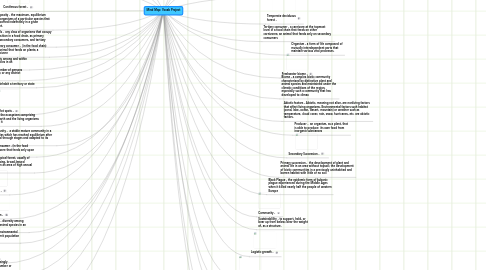Mind Map: Vocab Project
by Anthony DIRenzo

1. Population - the total number of persons inhabiting a country, city, or any district or area.
2. Ecosystem -
3. Biosphere - the ecosystem comprising the entire earth and the living organisms that inhabit it
4. Food web -
5. Primary consumer - (in the food chain) an animal that feeds on plants; a herbivore
6. Secondary consumer - (in the food chain) a carnivore that feeds only upon herbivores
7. Trophic levels - any class of organisms that occupy the same position in a food chain, as primary consumers, secondary consumers, and tertiary consumers.
8. Rainforest - a tropical forest, usually of tall, densely growing, broad-leaved evergreen trees in an area of high annual rainfall.
9. Coniferous forest -
10. Desert - a region so arid because of little rainfall that it supports only sparse and widely spaced vegetation or no vegetation at all: The Sahara is a vast sandy desert
11. Tundra - a vast treeless zone lying between the ice cap and the timberline of North America and Eurasia and having a permanently frozen subsoil
11.1. New node
12. Biodiversity - diversity among and within plant and animal species in an environment.
13. Hot spots -
14. Ecological succession - diversity among and within plant and animal species in an environment.
15. Pioneer species -
16. Climax community - a stable mature community in a successive series which has reached equilibrium after having evolved through stages and adapted to its environment
17. Limiting factors - an environmental factor that tends to limit population size.
18. Carrying capacity - the maximum, equilibrium number of organisms of a particular species that can be supported indefinitely in a given environment.
19. Population growth - increase in the number of people who inhabit a territory or state
20. Industrial Revolution - the totality of the changes in economic and social organization that began about 1760 in England and later in other countries, characterized chiefly by the replacement of hand tools with power-driven machines, as the power loom and the steam engine, and by the concentration of industry in large establishments.
21. Exponential growth - development at an increasingly rapid rate in proportion to the growing total number or size; a constant rate of growth applied to a continuously growing base over a period of time
22. Population growth rate -
23. Non-point source -
24. Organism - a form of life composed of mutually interdependent parts that maintain various vital processes.
25. Community -
26. Biome - a complex biotic community characterized by distinctive plant and animal species and maintained under the climatic conditions of the region, especially such a community that has developed to climax
27. Freshwater biome -
28. Producer - an organism, as a plant, that is able to produce its own food from inorganic substances
29. Tertiary consumer - a carnivore at the topmost level in a food chain that feeds on other carnivores; an animal that feeds only on secondary consumers
30. Temperate deciduous forest -
31. Grassland/ savannah -
32. Primary succession - the development of plant and animal life in an area without topsoil; the development of biotic communities in a previously uninhabited and barren habitat with little or no soil
33. Marine biome -
34. Biotic factors - Biotic, meaning of or related to life, are living factors. Plants, animals, fungi, protist and bacteria are all biotic or living factor
35. Abiotic factors - Abiotic, meaning not alive, are nonliving factors that affect living organisms. Environmental factors such habitat (pond, lake, ocean, desert, mountain) or weather such as temperature, cloud cover, rain, snow, hurricanes, etc. are abiotic factors.
36. Secondary Succession -
37. Black Plague - the epidemic form of bubonic plague experienced during the Middle Ages when it killed nearly half the people of western Europe
38. Sustainablility - to support, hold, or bear up from below; bear the weight of, as a structure.
39. Logistic growth -
40. J-Curve -
41. S-Curve -
42. Aquifer - any geological formation containing or conducting ground water, especially one that supplies the water for wells, springs, etc.
43. Water pollution - The addition of harmful chemicals to natural water. Sources of water pollution in the United States include industrial waste, run-off from fields treated with chemical fertilizers, and run-off from areas that have been mined.
44. Point source -
45. Food chain -


